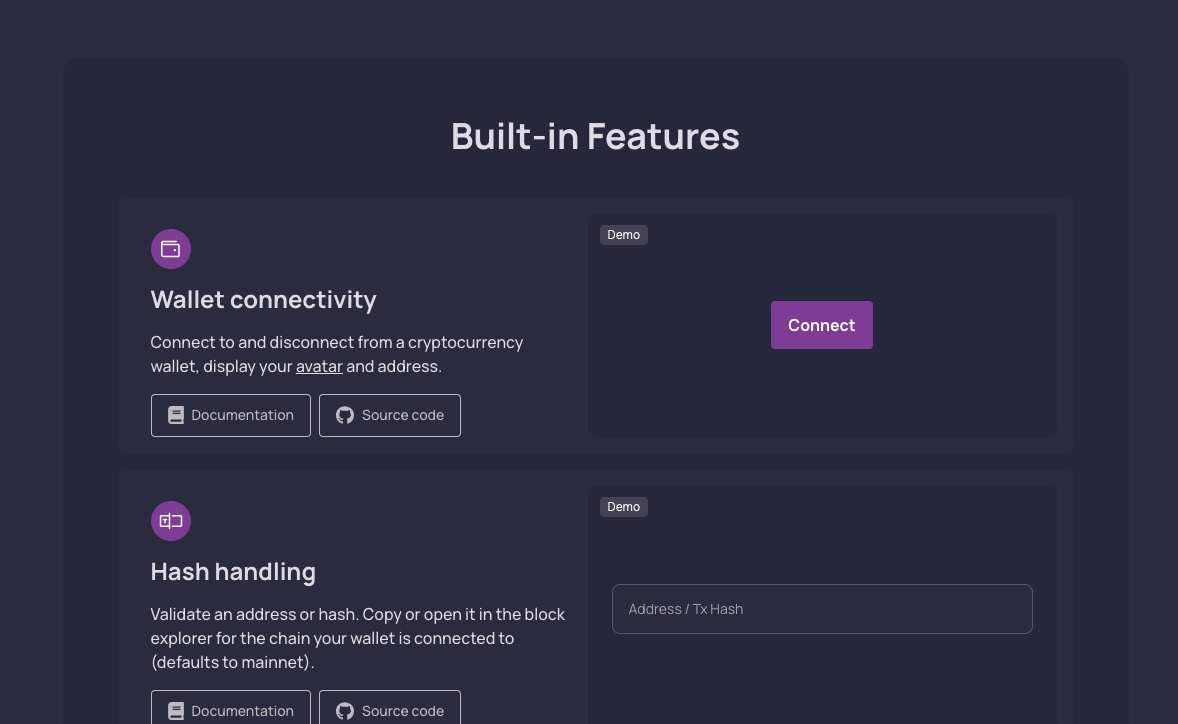Get Boosted: Power Up Your dApp Development


Get Boosted: Kickstart Your dApp Development
What if spinning up a new decentralized app was as easy as running a couple commands? dAppBooster makes that dream a reality. This starter kit is like rocket fuel for your Web3 project – it comes loaded with a modern stack and best practices so you can skip the boring setup and jump straight into coding.
After years of building dApps, the team at BootNode created dAppBooster to tackle all those pesky setup hurdles (think config files, project structure, multi-chain support) and save you serious time. The result? Starting a new dApp is smoooooth and actually kinda fun. If you’re a developer who’s tired of reinventing the wheel for every project, dAppBooster is definitely worth checking out.
Why dAppBooster Rocks (A Quick Overview)
dAppBooster isn’t just another template – it’s a full-blown dApp development booster pack built on the latest and greatest tools in the ecosystem. We’re talking React + Vite for a fast, modern frontend, TypeScript for type safety, Wagmi + viem for seamless blockchain interactions, and more. Under the hood, it focuses on developer experience, performance, and a sensible project structure. Here’s a taste of what you get out of the box:
- Modern Stack: Built with React, Vite, TypeScript, Wagmi, viem, and TanStack libraries – all integrated so you don’t have to.
- Flexible Project Structure: A clean organization for contracts, ABIs, subgraphs, and common components, so your code isn’t all over the place.
- Multi-Chain Ready: Native support for multiple chains with intuitive, type-safe configuration. Want Ethereum mainnet and a couple testnets in your app? It’s already set up.
- Wallet Connectivity Built In: Plug-and-play support for popular wallet connectors like ConnectKit, RainbowKit, and Web3Modal. No more wrestling with wallet integration – just choose your preferred library and go.
- Pre-built Components: Common UI components for dApps (forms, inputs, etc.) that are tree-shakable. Use what you need and lose the rest – keeping your bundle's bloat in check.
- Subgraph Integration: First-class support for subgraphs across networks, including auto-generated typed React hooks for querying data. In plain English: your frontend can pull data from The Graph with minimal fuss.
Not too shabby, right? Essentially, dAppBooster gives you a turbocharged starter project so you can focus on your dApp’s logic instead of yak-shaving build setups and library configs. Now let’s dive into how to actually get this thing running!
Cloning dAppBooster
Alright, time to get our hands dirty: The easiest way is via npx. This will fetch and run the dAppBooster install script
npx dappbooster dAppBooster-firstDapp
Boom! 🧨 running the above creates a new folder called dAppBooster-firstDapp in your current directory and populate it with the dAppBooster starter kit. This is the quickest way to get started, and it’s what we’ll use in this guide. You can opt between a clean version and a full featured version which includes all the examples for you to explore (if you choose the latter, you will have to configure some environment variables later on, check the IMPORTANT section below).
Next, step into your new project directory and install the dependencies:
cd dAppBooster-firstDapp && pnpm i
This will grab all the NPM packages the project needs (React, ethers, Wagmi, etc.). Note: The dAppBooster template uses pnpm by default for package management (it’s faster and more efficient than npm). If you don’t have pnpm yet, you can try using npm or yarn, but it’s recommended to stick with pnpm for consistency.
After running pnpm i, you should have all dependencies in place. At this point, you might want to do a couple of tiny housekeeping updates to personalize your new app:
- Open
package.jsonand update the"name"fields from the generic defaults to something relevant for your project. (This isn’t strictly necessary, but it’s nice to have your project’s name reflected there instead of "dAppBooster-firstDapp" 😅). - If you’re using version control (you probably are), you now have a fresh git repository initialized for you. The CLI wiped the old commit history, so consider making an initial commit for your brand new dApp codebase.
dAppBooster’s project structure is all set up and ready. Feel free to poke around the folders: you’ll see a logical layout with a src/ directory containing components/ (shared vs page-specific components), routes/ for the pages (using TanStack Router), constants/ for things like contract ABIs, lib/ for configs (like network configurations), and so on. The idea is that everything has its place – meaning you don’t have to invent a structure; you can just follow the established conventions.
Configuring Your dApp
Your new dApp is almost ready to launch, but there are a couple of configuration steps to make it truly yours. In practice, most of the configuration is straightforward and can be done in environment files or small code config files. Right after initialization, you should do the following:
-
Environment Variables: There’s an example env file in the project. Copy it and set up your own values. For instance, run:
cp .env.example .env.localThis creates a
.env.localfile with default settings and optional variables ready to be customized. -
WalletConnect Project ID (optional): Open up
.env.localin your editor – you’ll see some environment variables listed. You can get a Project ID for free from the WalletConnect dashboard. In the.env.localfile, find the line forPUBLIC_WALLETCONNECT_PROJECT_IDand paste in your ID:# WalletConnect Project ID PUBLIC_WALLETCONNECT_PROJECT_ID=<your-project-id> -
IMPORTANT
If you chose the full featured version when cloning the repo, you will have to add and configure the following variables in .env.local for the subgraph demos to work (the dApp will throw an error otherwise).
# Subgraph
PUBLIC_SUBGRAPHS_API_KEY=
# 'development' or 'production'
PUBLIC_SUBGRAPHS_ENVIRONMENT='development'
# comma separated list of <chainId>:<subgraphId>:<resourceId>
# (only use the chains your dApp needs)
UNISWAP_ARB=
UNISWAP_POLYGON=
UNISWAP_OP=
AAVE_BASE=
PUBLIC_SUBGRAPHS_CHAINS_RESOURCE_IDS='$UNISWAP_ARB,$UNISWAP_POLYGON,$UNISWAP_OP,$AAVE_BASE'
# URLs for the subgraphs in development and production
# must have the replaceable strings [api-key], [resource-id], and optionally [subgraoh-id]
PUBLIC_SUBGRAPHS_DEVELOPMENT_URL='https://api.studio.thegraph.com/query/[apiKey]/[subgraphId]/[resourceId]'
PUBLIC_SUBGRAPHS_PRODUCTION_URL='https://gateway-arbitrum.network.thegraph.com/api/[apiKey]/subgraphs/id/[resourceId]'
After this is done, run:
pnpm run subgraph-codegen
You can read more about this here and here.
And done, you're all set!
With these configs done, your dApp’s core settings are in place. 👍 Most other things are already configured sensibly by dAppBooster, so you typically won’t need to mess with anything else to run the app.
Start the development server: Use the handy script to fire up a local dev server:
pnpm dev
This will compile the app and launch it in development mode (with hot-reloading and all that jazz). Open the URL it provides (usually http://localhost:5173 or a similar port) in your browser. You should see your new dApp’s homepage up and running! 🎉 It might be a simple template page for now (probably a boilerplate welcome screen or the components' demo list if you chose that), but the important part is that everything is wired up. You can log in with a wallet, switch networks, etc.
Now that our dApp is configured and tested in development, it’s time for the final step: deploying it to the world.
Wrapping Up
In this walkthrough, we took a tour of dAppBooster - from its why-is-this-cool intro, through installation, project initialization, config, and finally deployment. In a matter of minutes, you can go from nothing to a fully working scaffold of a decentralized application, complete with multi-chain support and wallet connectivity baked in.
To recap the highlights: dAppBooster brings you a plug-and-play dApp template powered by a modern stack, saving you from the boilerplate grind. You used the CLI to spin up a new project with one command, configured a couple of things like environment variables, and you were off to the races running your app locally and then deploying it. Instead of spending days setting up tooling, you can immediately start building features unique to your dApp.
If you’re building a Web3 frontend, give dAppBooster a try – it’s open source (MIT licensed) and ready to save you time. As the docs put it, it makes starting a new dApp smoother by focusing on what matters: development experience, stability, and performance. Now go forth and build awesome dApps, faster! 🚀
